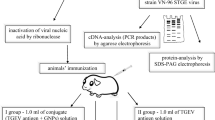The effect of a bacterial lysate complex IRS 19 on local and systemic manifestations of inflammation was studied in a rat model of aseptic lymphadenitis. Injection of λ-carrageenan into the cervical lymph node via surgical approach caused an increase in the thickness of the capsule, disturbances in histoarchitecture, the appearance of necrosis foci, histiocytosis of subcapsular and cerebral sinuses in the lymph node, as well as an increase in the level of TNFα in the blood serum and the number of circulating leukocytes and neutrophils. Course intranasal administration of bacterial lysate complex in this model dose-dependently reduced the level of these markers of the systemic inflammatory response and the severity of microstructural disorders in the affected lymph nodes. Thus, bacterial lysate complex after intranasal administration produces a systemic anti-inflammatory effect that goes beyond the respiratory tract.
Similar content being viewed by others
References
Kalyuzhin OV. OM-85 in the prevention/treatment of respiratory infections and exacerbations of chronic lung diseases: selection criteria, mechanisms and evidence. Lech. Vrach. 2018;(3):77-82. Russian.
Kalyuzhin OV. Topical bacterial lysates in the prevention and treatment of respiratory infections. Prakt. Med. 2016;(2-2):69-74. Russian.
Kryshen KL, Kukharenko AE, Vichare AS, Gaidai EA, Kryshen AA, Gushchin YaA, Kalyuzhin OV, Makarova MN, Makarov VG, Mahadevan B. Anti-inflammatory and immunomodulating effects of the bacterial lysate in the in vivo models of aseptic lymphadenitis and pneumococcal pneumonia. Med. Immunol. 2020;22(1):111-122. https://doi.org/10.15789/1563-0625-AAI-1758. Russian.
Muzhikyan AA, Khodko S, Gushin Y, Makarova M, Makarov V. Histological changes in the lymph nodes of rats in modeling acute cervical lymphadenitis. Mezhdunar. Vestn. Veterinarii. 2017;(1):75-83. Russian.
Tesakova SV, Samusenko IA, Karachinskaya IV, Kryshen KL, Abrashova TV, Makarova MN, Makarov VG. An experimental model of cervical lymphadenitis in rats to evaluate the efficacy of anti-inflammatory medicines. Prof. Klin. Med. 2011;(1):57-62. Russian.
Bacterial lysate medicines for respiratory conditions to be used only for prevention of recurrent infections, EMA/502527/2019, 09 September 2019. European Medicines Agency, 2019.
Chistiakov DA, Bobryshev YV, Kozarov E, Sobenin IA, Orekhov AN. Intestinal mucosal tolerance and impact of gut microbiota to mucosal tolerance. Front. Microbiol. 2015;5:781. https://doi.org/10.3389/fmicb.2014.00781
Del-Rio-Navarro BE, Espinosa Rosales F, Flenady V, Sienra-Monge JJ. Immunostimulants for preventing respiratory tract infection in children. Cochrane Database Syst. Rev. 2006;(4):CD004974. https://doi.org/10.1002/14651858.CD004974.pub2
Esposito S, Soto-Martinez ME, Feleszko W, Jones MH, Shen KL, Schaad UB. Nonspecific immunomodulators for recurrent respiratory tract infections, wheezing and asthma in children: a systematic review of mechanistic and clinical evidence. Curr. Opin. Allergy Clin. Immunol. 2018;18(3):198-209. https://doi.org/10.1097/ACI.0000000000000433
Feleszko W, Rossi GA, Krenke R, Canonica GW, Van Gerven L, Kalyuzhin O. Immunoactive preparations and regulatory responses in the respiratory tract: potential for clinical application in chronic inflammatory airway diseases. Expert Rev. Respir. Med. 2020;14(6):603-619. https://doi.org/10.1080/17476348.2020.1744436
Kearney SC, Dziekiewicz M, Feleszko W. Immunoregulatory and immunostimulatory responses of bacterial lysates in respiratory infections and asthma. Ann. Allergy Asthma Immunol. 2015;114(5):364-369. https://doi.org/10.1016/j.anai.2015.02.008
Pivniouk V, Gimenes-Junior JA, Ezeh P, Michael A, Pivniouk O, Hahn S, VanLinden SR, Malone SP, Abidov A, Anderson D, Gozdz J, DeVries A, Martinez FD, Pasquali C, Vercelli D. Airway administration of OM-85, a bacterial lysate, blocks experimental asthma by targeting dendritic cells and the epithelium/IL-33/ILC2 axis. J. Allergy Clin. Immunol. 2021;(Sep 22):S0091-6749(21)01403-2. https://doi.org/10.1016/j.jaci.2021.09.013
Rezende RM, Cox LM, Weiner HL. Mucosal tolerance therapy in humans: Past and future. Clin. Exp. Neuroimmunol. 2019;10(Suppl. 1):20-31. https://doi.org/10.1111/cen3.12500
Wambre E, Jeong D. Oral tolerance development and maintenance. Immunol. Allergy Clin. North Am. 2018;38(1):27-37. https://doi.org/10.1016/j.iac.2017.09.003
Author information
Authors and Affiliations
Corresponding author
Additional information
Translated from Byulleten’ Eksperimental’noi Biologii i Meditsiny, Vol. 173, No. 3, pp. 357-362, March, 2022
Rights and permissions
About this article
Cite this article
Kryshen, K.L., Gaidai, D.S., Gushchin, Y.A. et al. Bacterial Lysate Complex Administered Intranasally Suppresses Inflammation in an In Vivo Model of Aseptic Lymphadenitis. Bull Exp Biol Med 173, 361–365 (2022). https://doi.org/10.1007/s10517-022-05549-5
Received:
Published:
Issue Date:
DOI: https://doi.org/10.1007/s10517-022-05549-5




